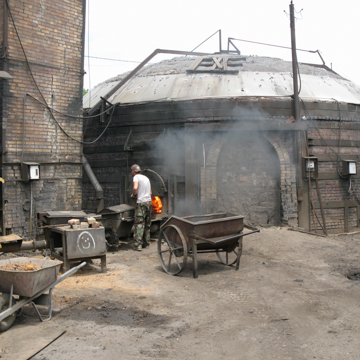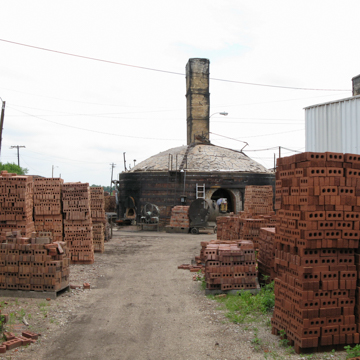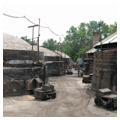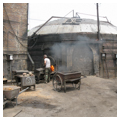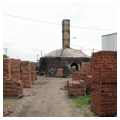You are here
Colonial Brick Corporation
Located in the small town of Cayuga, on the western border of Central Indiana, the Colonial Brick Corporation was one of the country’s last remaining companies to make bricks using coal-fired beehive kilns. Originally established as the Cayuga Brick and Coal Company in 1904, and later the Acme Brick Company, the site has continuously produced bricks for a century.
The 50-acre property is southeast of Cayuga’s town center. Ten original brick beehive kilns, encircled by metal support bands, are the main structures on the site, which also contains a grinder building and other support structures. The kilns have been rebuilt over the years as the brick became brittle from the continuous firings. The dome-shaped roofs, also of brick, are impressive engineering feats. Some have been covered with metal domes from old grain bins in order to preserve them. The red brick wall fronting West Park Street (County Road 400), the remaining vestige of a former building erected by the Acme Brick Company, still bears that company’s name in contrasting yellow brick.
The company mined its clay and shale from a pit located behind the plant property. It includes a 25-foot seam of red burning shale with an 8-foot seam of buff burning clay beneath it. By using varying proportions of the two in the mixture, a wide range of brick body colors can be achieved. The Colonial Brick Corporation’s bestselling brick was the Mohawk Clinker, a chunky, multi-hued brick.
When first built in 1904, power for the facility came from a huge steam engine that operated the grinders. Electricity has powered the plant for many years, but the other processes have remained virtually the same. Since 1965, the property has been owned by the Swartz family, which operated the kilns as the Colonial Brick Corporation. Due to its traditional brickmaking processes, the company has been important to historic preservation efforts, since it could duplicate the colors, shapes, and textures of early-twentieth-century bricks.
Unable to compete with the modern brick-making business, whose factories could produce upwards of 140 million bricks a year compared to Colonial Brick’s 12 million bricks, the Swartz family closed its operation in 2015. The property was listed for sale in 2016.
References
“Historic Bricks Demand a Historic Brickworks.” Indiana Landmarks. Accessed April 19, 2018. http://indianalandmarks.org/.
Tigg, Lisa. “Last of its kind: After 50 years of ownership, lone producer of clinker bricks puts biz up for sale.” Tribune Star(Terre Haute), April 17, 2016.
Writing Credits
If SAH Archipedia has been useful to you, please consider supporting it.
SAH Archipedia tells the story of the United States through its buildings, landscapes, and cities. This freely available resource empowers the public with authoritative knowledge that deepens their understanding and appreciation of the built environment. But the Society of Architectural Historians, which created SAH Archipedia with University of Virginia Press, needs your support to maintain the high-caliber research, writing, photography, cartography, editing, design, and programming that make SAH Archipedia a trusted online resource available to all who value the history of place, heritage tourism, and learning.















